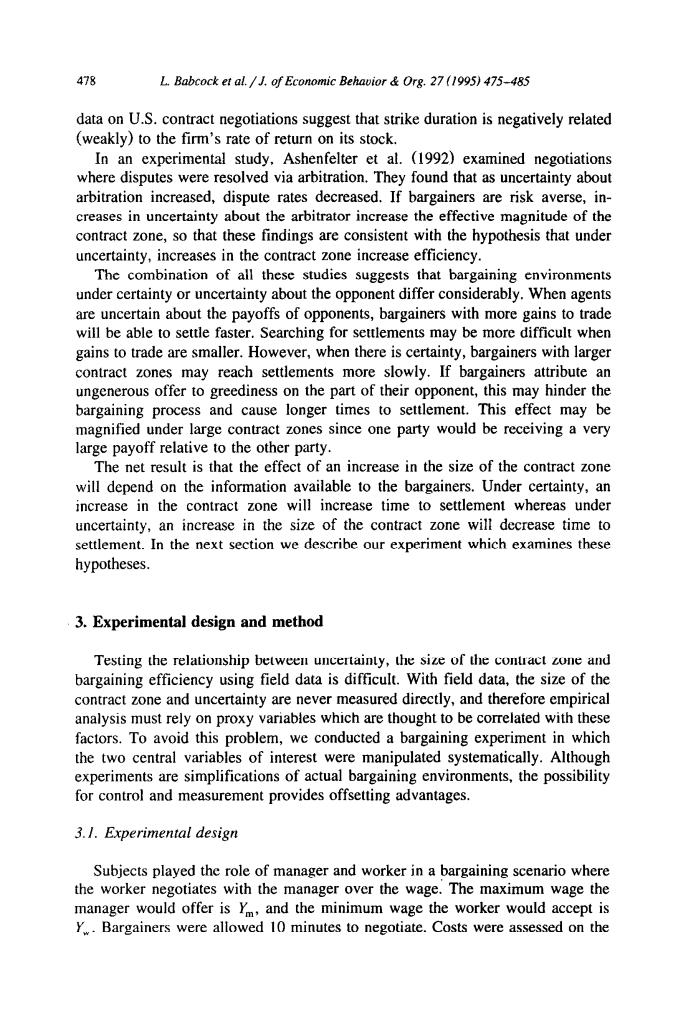正在加载图片...

478 L.Babcock et al./J.of Economic Behavior Org.27(1995)475-485 data on U.S.contract negotiations suggest that strike duration is negatively related (weakly)to the firm's rate of return on its stock. In an experimental study Ashenfelter et al.(1992) examined negotiations where disputes were resolved via arbitration.They found that as uncertainty about arbitration increased,dispute rates decreased.If bargainers are risk averse,in- creases in uncertainty about the arbitrator increase the effective magnitude of the contract zone,so that these findings are consistent with the hypothesis that under uncertainty,increases in the contract ne increas efficiency. The combination of all these studies suggests that bargaining environments under certainty or uncertainty about the opponent differ considerably.When agents are uncertain about the payoffs of opponents,bargainers with more gains to trade will be able to settle faster.Searching for settlements may be more difficult when gains to trade are smaller.However,when there ertain bargai ers with larger contract zones may reach settlements more slowly.If bargainers attribute an ungenerous offer to greediness on the part of their opponent,this may hinder the bargaining process and cause longer times to settlement.This effect may be magnified under large contract zones since one party would be receiving a very yoff relative to the other party. effect an increa e in the size of the contractzon will depend on the information available to the bargainers.Under certainty,an increase in the contract zone will increase time to settlement whereas under uncertainty,an increase in the size of the contract zone will decrease time to settlement.In the next section we describe our experiment which examines these hypotheses 3.Experimental design and method Testing the relationship betv certainty,the size of the contract cone and bargaining efficie ncy using field data is difficu With field data,the size of the contract zone and uncertainty are never measured directly,and therefore empirical analysis must rely on proxy variables which are thought to be correlated with these factors.To avoid this problem,we conducted a bargaining experiment in which atically.Although are simplifications of a actual environments,the possibility for control and measurement provides offsetting advantages 3.1.Experimental design subiects plaved the role of manager and worker in a bargaining scenario where the worker negotiates with the manager over the wage.The maximum wage the would offer is Y the worker would ac Costs were a I on the478 L. Babcock et al. / J. of Economic Betmuior & Org. 27 119951475-485 data on U.S. contract negotiations suggest that strike duration is negatively related (weakly) to the firm’s rate of return on its stock. In an experimental study, Ashenfelter et al. (1992) examined negotiations where disputes were resolved via arbitration. They found that as uncertainty about arbitration increased, dispute rates decreased. If bargainers are risk averse, increases in uncertainty about the arbitrator increase the effective magnitude of the contract zone, so that these findings are consistent with the hypothesis that under uncertainty, increases in the contract zone increase efficiency. The combination of all these studies suggests that bargaining environments under certainty or uncertainty about the opponent differ considerably. When agents are uncertain about the payoffs of opponents, bargainers with more gains to trade will be able to settle faster. Searching for settlements may be more difficult when gains to trade are smaller. However, when there is certainty, bargainers with larger contract zones may reach settlements more slowly. If bargainers attribute an ungenerous offer to greediness on the part of their opponent, this may hinder the bargaining process and cause longer times to settlement. This effect may be magnified under large contract zones since one party would be receiving a very large payoff relative to the other party. The net result is that the effect of an increase in the size of the contract zone will depend on the information available to the bargainers. Under certainty, an increase in the contract zone will increase time to settlement whereas under uncertainty, an increase in the size of the contract zone will decrease time to settlement. In the next section we describe our experiment which examines these hypotheses. 3. Experimental design and method Testing the relationship between uncertainty, the size of the contract zone and bargaining efficiency using field data is difficult. With field data, the size of the contract zone and uncertainty are never measured directly, and therefore empirical analysis must rely on proxy variables which are thought to be correlated with these factors. To avoid this problem, we conducted a bargaining experiment in which the two central variables of interest were manipulated systematically. Although experiments are simplifications of actual bargaining environments, the possibility for control and measurement provides offsetting advantages. 3. I. Experimental design Subjects played the role of manager and worker in a bargaining scenario where the worker negotiates with the manager over the wage: The maximum wage the manager would offer is Y,, and the minimum wage the worker would accept is Y, . Bargainers were allowed 10 minutes to negotiate. Costs were assessed on the